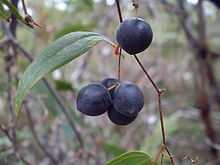Smilax glyciphylla
| Sweet Sarsaparilla | |
|---|---|
 | |
| Scientific classification | |
| Kingdom: | Plantae |
| (unranked): | Angiosperms |
| (unranked): | Monocots |
| Order: | Liliales |
| Family: | Smilacaceae |
| Genus: | Smilax |
| Species: | S. glyciphylla |
| Binomial name | |
| Smilax glyciphylla Sm. | |
Smilax glyciphylla, the Sweet Sarsaparilla, is a dioecious climber native to eastern Australia. It is widespread in rainforest, sclerophyll forest and woodland; mainly in coastal regions.
The leaves are distinctly three-veined with a glaucous under-surface, lanceolate, 4–10 cm long by 1.5–4 cm wide. Coiling tendrils are up to 8 cm long. The globose berries are 5–8 mm diam., black with a singular seed.[1]
Uses
The sweet flavoured leaves are used medicinally[2] by Aborigines and non-indigenous colonists, including as a tea substitute[3]
It was used medicinally in the earliest days of the colony of Port Jackson for treating scurvy, coughs and chest complaints. In correspondence to England in November 1788, Dennis Considen wrote: "I have sent you some of the sweet tea of this country which I recommended and is generally used by the marines and convicts as such it is a fair antiscorbutic as well as a substitute for tea which is more costly."[4]
It was recommended as a tea alternative, tonic and antiscorbutic, and was still being traded at least up until the late 19th Century by Sydney herbalists. [5] It is claimed to have similar properties to Jamaican sarsaparilla, Smilax regelii.
The leaves, stems, and flowers contain the glycoside glyciphyllin, which has a bitter-sweet taste and may be the active medicinal component.[6][7][8]
Recent research shows that S.glycipylla has antioxidant activity [9]
References
- ↑ Smilax glyciphylla plant profile, PlantNET
- ↑ Lassak, E.V., & McCarthy, T., Australian Medicinal Plants, Methuan Australia, pp91-92, 1983, ISBN 0-454-00438-9.
- ↑ White, J., Journal of a Voyage to New South Wales, 1790
- ↑ Copy of letter received by Dr Anthony Hamiltion, from Dennis Considen, 18 November, 1788, and sent onto Joseph Banks.
- ↑ Maiden, J.H., The Useful Plants of Australia, 1889, p203.
- ↑ Rennie, E.H., Glycyphyllin, the sweet principle of Smilax glycyphylla, Journal of the Chemical Society Journal Transactions, 49, 1886.
- ↑ Maiden, J.H., The Useful Plants of Australia, 1889, p203-204.
- ↑ Hegnauer, R., Chemotaxonomie der Pflanzen, vol. 2, Birkhauser Verlag, Basel, 1963.
- ↑ Cox, S.D., Jayasinghea, K.C., and Markhama, J.L., Antioxidant activity in Australian native sarsaparilla (Smilax glyciphylla), Journal of Ethnopharmacology, Vol. 101, Issues 1-3, 3 October 2005, pp162-168.